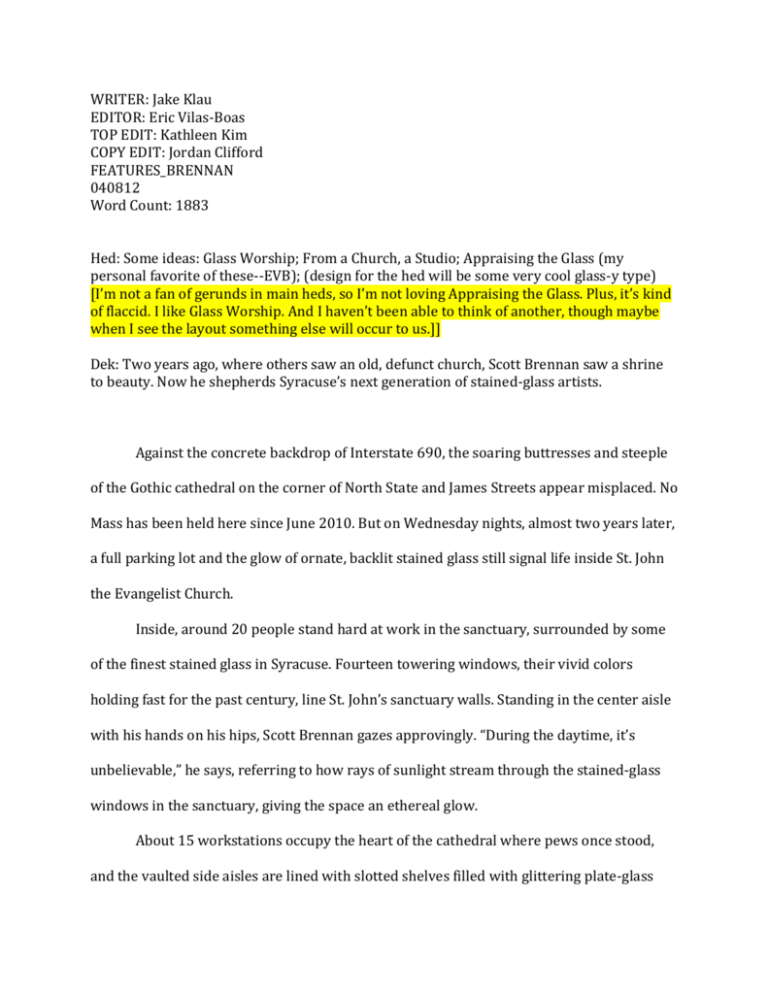features_brennan_copyedit_klau_040812
advertisement

WRITER: Jake Klau EDITOR: Eric Vilas-Boas TOP EDIT: Kathleen Kim COPY EDIT: Jordan Clifford FEATURES_BRENNAN 040812 Word Count: 1883 Hed: Some ideas: Glass Worship; From a Church, a Studio; Appraising the Glass (my personal favorite of these--EVB); (design for the hed will be some very cool glass-y type) [I’m not a fan of gerunds in main heds, so I’m not loving Appraising the Glass. Plus, it’s kind of flaccid. I like Glass Worship. And I haven’t been able to think of another, though maybe when I see the layout something else will occur to us.]] Dek: Two years ago, where others saw an old, defunct church, Scott Brennan saw a shrine to beauty. Now he shepherds Syracuse’s next generation of stained-glass artists. Against the concrete backdrop of Interstate 690, the soaring buttresses and steeple of the Gothic cathedral on the corner of North State and James Streets appear misplaced. No Mass has been held here since June 2010. But on Wednesday nights, almost two years later, a full parking lot and the glow of ornate, backlit stained glass still signal life inside St. John the Evangelist Church. Inside, around 20 people stand hard at work in the sanctuary, surrounded by some of the finest stained glass in Syracuse. Fourteen towering windows, their vivid colors holding fast for the past century, line St. John’s sanctuary walls. Standing in the center aisle with his hands on his hips, Scott Brennan gazes approvingly. “During the daytime, it’s unbelievable,” he says, referring to how rays of sunlight stream through the stained-glass windows in the sanctuary, giving the space an ethereal glow. About 15 workstations occupy the heart of the cathedral where pews once stood, and the vaulted side aisles are lined with slotted shelves filled with glittering plate-glass slabs of every color and texture. The church organ’s pipe stacks still stare down in monolithic silence from the balcony. Near the altar, a little boy plays the melody from Beethoven’s “Für Elise” on an old piano, a tune drowned out by sounds of hammering, grinding, and clinking glass. Last November, the Brennan Stained Glass Studio celebrated its grand opening at St. John’s. Of the five stained-glass studios in the Syracuse area, Brennan’s is the largest and, remarkably, the only one housed in the natural setting for stained glass — a church sanctuary. The studio offers classes on stained-glass making on Wednesdays and tonight, the place is bustling. Under the sanctuary’s arched ceiling, Brennan, a 56-year-old spitting image of George Lucas, wanders among the workstations. He chats with his students, offering tips and assessing their progress as they putter away at projects. Brennan thrives during the night classes. That’s when he gets to interact with people. “I can’t wait to get to work,” he says. “I love what I do so much.” Tonight is Tracie Kellum-Waldon’s first class. Her untried hands somewhat shaky, she places clear pieces of plate glass over a variety of shapes printed on paper. After tracing the shape onto the glass, she scores and breaks it, creating aesthetic and form where moments earlier there was only a simple square. “I’m giving it a try,” she says. “If I can, I’m going to keep doing it.” Kellum-Waldon traveled from Oneida to attend the class. She plans on making it a serious hobby, but taking the class is also her way of thanking Brennan for saving St. John’s from abandonment and squalor. “We’re in a disposable society. There’s no appreciation for the old-school way of doing things,” she says. The preservation of St. John’s stained-glass windows and an altar that took generations to build has earned the studio her appreciation. “These people saved it,” she says. In 2010, Bishop Robert Cunningham ordered the congregation to merge with the Cathedral of the Immaculate Conception six blocks south. The move left an uncertain future for St. John’s, a 160-year-old staple of the Syracuse cityscape. It’s becoming a familiar occurrence in Syracuse, where recent mergers have left a few of the city’s beloved cathedrals in a purgatory of sorts. Icons like Holy Trinity and South Presbyterian now sit closed and empty, a fate St. John’s escaped. While the Syracuse Roman Catholic Diocese watched another of its historic churches succumb to increasing costs and waning membership, Brennan saw an opportunity. He was looking to expand and position his studio closer to the city. When he heard that St. John’s would close, it wasn’t a difficult decision to relocate to a space that espoused the beauty of his life’s work. It was difficult for the evicted congregation, though. They struggled with the idea of turning the cathedral into a business. “The part they like about us is that we promised to keep the doors open and let anybody come in,” Brennan says. “And we didn’t make any changes, we kept it intact.” Once run out of his parent’s basement in Eastwood, the studio has moved to a variety of spaces since it started in 1975. Before the last move in 2011, Brennan was operating out of an old Coca-Cola bottling plant on West Genesee Street, across from the Basilica of the Sacred Heart of Jesus. For nearly 40 years, Brennan has restored centuriesold stained-glass windows — a responsibility he shares with his son, Chris, his daughter, Kim, and a crew of seven. But for him, it’s more than a job. In 2001, Brennan and his team completed the 28-foot-wide stained glass dome in the ceiling of the grand entrance at Boldt Castle in the Thousand Islands. Brennan lost money as the lowest bidder for the $200,000 contract, but it earned him a reputation and pride. It doesn’t hurt that an average of 200,000 tourists visit Boldt Castle every year. Like Solomon’s Temple in ancient Jerusalem, St. John’s also has a holy of holies, a restricted area off-limits to the students — its basement. Once home to youth group meetings and church dinners, now the basement houses a separate studio for the restoration of priceless works like stained-glass windows and antique Tiffany lamps, objects too expensive and fragile to leave unprotected. A 100-year-old Tiffany figural window from Mount Pleasant United Methodist, a quaint church in the countryside north of Fulton, lays in hundreds of little pieces on a wide worktable. The original 1911 invoice put a $600 price tag on all of the windows in the church, but Brennan says restoring this one window will cost almost 50 times that. The window has suffered through a century of the worst Northeast winters, but if Brennan’s other projects can speak to its success, the restored window will suck the breath from the congregation when his crew reinstalls it. Most of Brennan’s business centers on refurbishing and maintaining stained-glass windows — a lucrative endeavor that nets clients from all over Central New York, and from as far away as the Adirondacks. He says the rule of thumb is that stained-glass panels need restoring once a century. A full restoration includes complete disassembly and reassembly. Nature sometimes does the former. “We’ve had windows brought to us in a garbage can,” says Zeke Chatsworth, who has worked at the studio for 15 years. Using only a picture of the original, which was blown out in a storm, the team restored the window to its original glory. On how much time that took, Chatsworth remarks, “Quite a bit.” Because many churches in Central New York were built at least a century ago, orders for restoration hit the studio on a regular basis. Chatsworth says the studio is currently working on projects with around 10 churches in the region. Even the government occasionally solicits Brennan’s expertise. The studio received a $28,687 contract in January for the removal and replacement of stained-glass windows at Fort Drum. Brennan plans to restore his own windows at St. John’s in the future, a job he says will cost around $1 million. Of course, he can do the labor in-house. Aside from restoration work, the studio serves another purpose. Brennan insists on creating avenues for the public to get involved in the arts, and not just the art of stained glass. “Anything that’s really creative is what we’re about,” he says. There’s a spectrum of student projects in the works around the studio. Under the watchful eye of Kim Brennan, a group of chatty ladies surround a large island workstation near the front of the sanctuary to work on jewelry and Christmas ornaments. Tonight, Kim is teaching them how to create fused glass, a form characterized by kiln firing so that glass pieces melt together. Like her father and brother, Kim knows all areas of the stained-glass business. “I do everything,” she says. Brennan stops to admire a transom window that Mary Agnew, a Crouse Hospital administrator, is building to adorn the front door of her Jamesville home. A product of Agnew’s creativity and effort, the transom features orange triangles and clear rectangular facets. “You see what she’s doing right here?” Brennan asks, with a grin. “She works with the highest technology within her business and yet she comes here and does everything by hand.” Most of the work in the studio is done with hand tools. Agnew is equipped with only a few markers, a ruler, and a scoring tool. “That’s why I think people enjoy this,” Brennan says. “No screen, no computer; all hand.” Agnew, who jokingly calls herself a “bureaucrat” at her day job, says working with her hands at the studio is rewarding. “At the end of the day I have nothing tangible,” she laments, as she measures a piece of orange glass and brushes blond hair out of her face. “But I get here, I’m focused, and there’s an actual product. There’s something beautiful.” Brennan beams when overhearing that his life’s work offers relief for those caught up in the 9-to-5 humdrum. Brennan says his future plans include installing a sheet-glass furnace that will also serve to heat the cavernous sanctuary, and making the space more open to the public. His vision for the new space, which he plans on eventually christening “The Renaissance Center,” includes drawing and painting classes, fused-glass jewelry classes, and advanced drawing and design classes for stained glass. He even plans to build a stage and open the studio to performers. At the workstation to Agnew’s right, her 15-year-old son, Connor, stares at a small stained-glass window that looks finished, as if contemplating his next move. “It’s called mission style,” he comments on it, referring to the American Craftsman Movement that peaked in the 1930s. The window’s clear vertical panes are accented with minute trios of orange and turquoise-colored squares — colors that conjure images of a setting sun. Connor was drawn to stained glass when his mom asked for help on a large Frank Lloyd Wright–esque window with hundreds of geometric pieces. After helping her apply copper foil to the edges of each piece, Connor decided to start his own project. Agnew says the experience sparked a deeper interest in art for her son. “He’s also taking art class for the first time,” she says. “He’s been doing chorus, and he’s getting interested in drawing.” Brennan sees his project as a continuation of the former ministry of the church. He couldn’t have chosen a better spot, and he knows it. Sitting at a desk in an unused corner of the sanctuary near a lamp built with leftover glass from the dome project at Boldt Castle, Brennan looks like a simple man. Even though big cash flows through the studio, Brennan continues working hard. “I’m just a struggling artist. I swear to God,” he says. “I’ve had a middle-class income my whole life.” Brennan says frugality allowed him to get where he is, and allows him to do what he loves. “This place has expanded a lot because I didn’t take a lot,” he says, gesturing toward the grand studio. The space already attracts a crowd as vibrant as the glass within it. “We get great people,” he says, standing near the altar, with his students working before him. “I’m blessed.”







